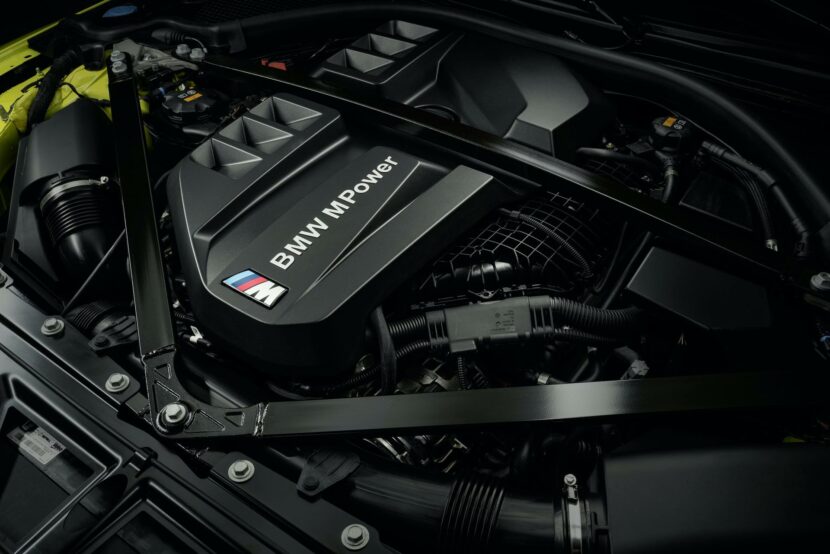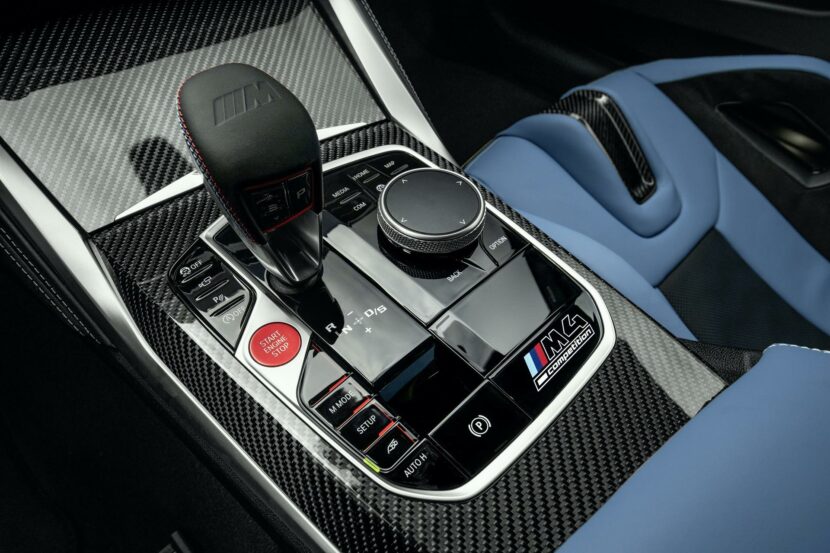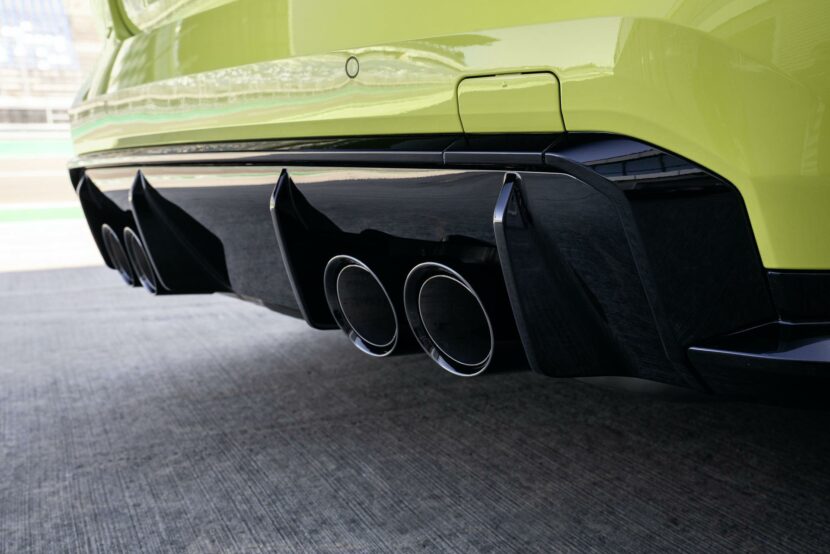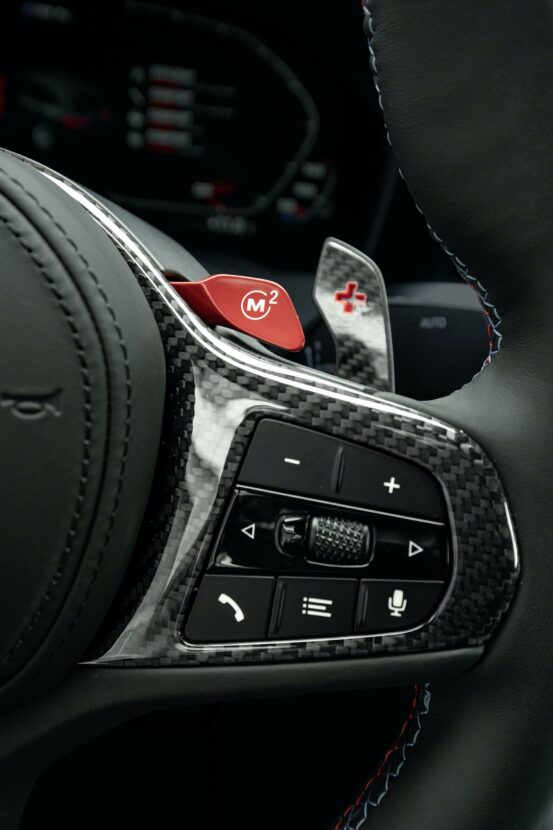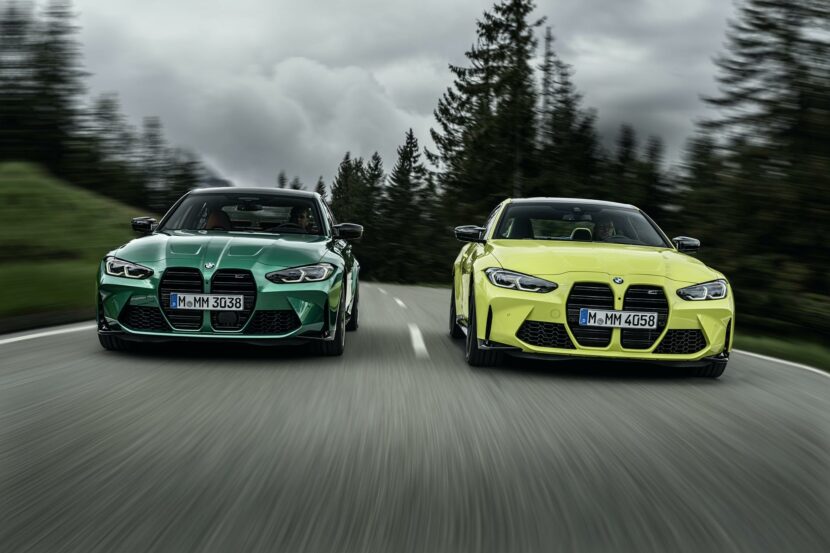The new BMW M3 and M4 generations are underpinned by a completely new architecture, developed on the basis of the CLAR rear-wheel drive architecture and tweaked for a new level of high performance. BMW says that the two M models from the upper end of the mid-class segment are developed to deliver razor-sharp driving performance and precision, in true BMW M style. All chassis and drivetrain are either brand new or entirely reengineered and thus the new G80 M3 and G82 M4 mark a decisive breakthrough and departure from the past models.
State-of-the-art 6-cylinder engine with high-revving characteristics
The running heart of the recently revealed M3 Sedan and M4 Coupe is the S58 engine, which specifically enhanced by the BMW M division using the B58 unit as starting point.
The straight-six petrol engine is offered in two output stages. The entry-level M3 and M4 models receive the 353 kW / 480 PS (473 hp) iteration of the powertrain, whereas the range-topping Competition versions are powered by the 375 kW / 510 PS (503 hp) version of the S58 unit.
Power delivery is performed either via six-speed manual gearbox or an 8-speed M Steptronic transmission with M Drivelogic management unit. The output essentially reaches the rear-axle wheels for both the 480 PS and the 510 PS Competition variants.
For the first time in history, the M3 Competition Sedan and the M4 Competition Coupe will be available for order with the optional M xDrive all-wheel drive traction system starting with next summer.
The 6-cylinder engine in use in the new M3 and M4 generations employs the M TwinPower Turbo technology. Contrary to the standard custom, this powerplant is actually equipped with two mono-scroll turbochargers, as a difference from the normal TwinPower Turbo engine that use a single, twin-scroll turbocharger.
Thus, compared to the preceding Competition models, the new high-end M3 and M4 variants now boast a power increase by up to 44 kW / 60 PS and a boost in peak torque achieved of up to 100 Nm (74 lb-ft). While the standard models promise 550 Nm (405 lb-ft) available over a wide rev range between 2,650 rpm and 6,130 rpm, the Competition iterations are good for no less than 650 Nm (479 lb-ft) that are continuously delivered between 2,750 rpm and 5,500 rpm.
The peak output of both engine declinations are fully achievable at 6,250 rpm, whereas the red line commences at 7,200 rpm.
Acceleration times are nonetheless impressive and improved compared to the outgoing model generations in both cases, as follows:
- M3 Sedan does 0-100 km/h in 4.2 seconds
- M3 Sedan does 0-200 km/h in 13.7 seconds
- 80-120 km/h acceleration in the M3 Sedan: 4.1 seconds (4th gear), 5.6 seconds (5th gear)
- M3 Competition Sedan does 0-100 km/h in 3.9 seconds
- M3 Competition Sedan does 0-200 km/h in 12.5 seconds
- 80-120 km/h acceleration in the M3 Competition Sedan: 2.6 seconds (4th gear), 3.4 seconds (5th gear)
- M4 Coupe does 0-100 km/h in 4.2 seconds
- M4 Coupe does 0-200 km/h in 13.7 seconds
- 80-120 km/h acceleration in the M4 Coupe: 4.1 seconds (4th gear), 5.6 seconds (5th gear)
- M4 Competition Coupe does 0-100 km/h in 3.9 seconds
- M4 Competition Coupe does 0-200 km/h in 12.5 seconds
- 80-120 km/h acceleration in the M4 Competition Coupe: 2.6 seconds (4th gear), 3.4 seconds (5th gear)
The top speed achieved by the new M3 and M4 models is strictly electronically limited to 250 km/h (150 mph). If you choose the optional M Driver’s Package, the speed limit is removed and the top value increases to a whooping 290 km/h (180 mph).
Special technical solutions for ensuring outstanding performance
The two mono-scroll turbochargers are recirculating the compressed exhaust gas to feed the 1-3 and 4-6 sequences of cylinders. The indirect intercooler controls and optimizes the airflow that enters the two fan chargers. The instantaneous power response of the turbochargers is possible due to the electronically-controlled wastegate of the intercooler.
Furthermore, this solution increases the effectiveness of the catalytic converter, whereas the flow-optimized design of the intercooler helps reduce the pressure losses in the dual-flow air intake system. It is important to highlight that all the new M3 Sedan and M4 Coupe versions are fully compliant with the strict EURO 6d emission standard.
Another key element found in the intricate architecture of the BMW S58 petrol engine is the High Precision Injection system which achieves a maximum pressure of 350 bar. The fuel-air mix is thus efficiently prepared, the injection times are shorter and the emission levels drop significantly due to the optimal flow of the combustion process.
The efficient engine cycle is further backed by the ingenious VALVETRONIC variable valve timing and the Double-VANOS variable valve lift technologies. Nonetheless, to further contribute to a cleaner environment and meeting all stringent emission limits, the S58 engine is also fitted with a petrol particulate filter.
Technical masterpiece: the cooling and oil supply systems
The engine powering the new M3 Sedan and M4 Coupe is fitted with state-of-the-art cooling and oiling mechanisms that ensure the smooth and efficient functioning in either normal and high-load utilization.
The cooling system comprises the generously-dimensioned front air vents, a low-temperature radiator, a high-temperature radiator, a horizontally-installed oil cooler, to ensure efficient heat loss, and an electrically-powered cooling fan, used at low rpm and whenever there is a need.
The air flows from the air intakes into the radiator following the sequence described previously. In the Competition models, due to higher engine needs, engineers have also installed a separate transmission oil cooler.
The low-temperature circuit supplies the needed coolant for the intercooler, whereas the high-temperature cooling mechanism provides the necessary heat-loss fluid to the engine block and turbochargers, using a mechanical water pump and three radiator (a main one and two additional ones installed inside the wheel arches.
After the engine has been switched, an additional electric water pump kicks in to cool down the turbocharging unit for a definite amount of time.
The oil supply system is inspired from motorsport and is intended specifically for racetrack driving. The system is gathering an oil sump with minimal weight characteristics and an integrated suction channel. The main oil sump features two separate chambers.
Where there’s extra need to oil the engine (in cases of extreme lateral and longitudinal accelerations), oil is drawn from the smaller chamber of the map-controlled sump through an additional suction stage.
Inspired from motorsport: the engine’s lightweight construction
The BMW M has put all its rich motor racing knowledge into the construction of the S58 powerplant powering the new M3 and M4 models. The architecture and materials used improve the structural rigidity and allow to keep the kerb weight as low as possible, also ensuring an efficient functioning.
At the base of the engine architecture stands the sleeve-free closed-deck construction, which significantly enhances the rigidity to a high level. The crankshaft is manufactured out of forged lightweight metals boasts an unparalleled level of torsional resistance and a reduced rotating mass, that help achieve the impressive output and torque levels specific to high-revving powerplants.
The 6-cylinders feature a wire-arc iron spray coating that fights to reduce the internal frictions and thus minimize inherent functioning losses, also enabling the maximum use of the mechanical force developed. Furthermore, the cylinder heads have been manufactured uses 3D printing techniques.
This metal casting technology has immense advantages over the traditional metal casting methods, as it allows an unprecedented level of precision and complexity. Using 3D printing for manufacturing the cylinder heads has paved the way to reduce the overall weight of the cylinder head cores and allow for a specific cooling duct architecture that optimizes the temperature management.
BMW promises great sound
The new BMW M3 and M4 use model-specific exhaust system featuring electrically controlled flaps. The special exhaust system features a dual-branch architecture and large cross sections that help minimize back pressure. The system is also fitted with a high-capacity rear silencer and ends with four circular exhaust pipes paired in twin groups, in true BMW M fashion.
The tailpipes are finished in Chrome on the 480 PS versions of the M3 Sedan and M4 Coupe, while the more powerful Competition models receive exhausts covered in glossy Black Chrome.
The flap-controlled exhaust system helps create a solid bond between the driver and the vehicle, delivering an impressively rich soundtrack and an undistorted engine note that further underlines the high-revving characteristics.
The volume of the exhaust can be controlled by means of the chosen engine modes via the M Sound Control button on the center console. You can choose between the SPORT and SPORT+ modes, which significantly boost the engine’s aural impact.
The six-speed manual transmission
With the advent of the M3 Sedan and M4 Coupe generation of models, BMW M proposes a daring and radically different approach, also unique in the high-performance mid class. The 480 PS variants of the G80 and G82 model series are now exclusively being offered with a classic six-speed manual gearbox that channels the power towards the rear-axle wheels.
The 6-speed manual gearbox is characterized by short and precise shifting times. As to ensure a smooth operation, the transmission is also fitted with the Gear Shift Assistant.
The function can be deactivated from the iDrive menu and uses engagement speed control to ensure slip-free operation in situations when the driver pushes the dynamic limits of the car, for example during downshifting under braking into corners.
The construction incorporates a new clutch bell housing and ensures a low overall weight for the six-speed manual tranny, which together with all components, is around 25 kilograms lighter than the 8-speed M Steptronic automatic gearbox fitted on the Competition models.
Furthermore, the gear ratios and gear spread in the case of the new 6-speed manual transmission are perfectly matched to the engine’s high-revving feature and the impressive amount of peak output and torque. This enables sustained acceleration and speed burst across the entire rev range, promising an exhilarating driving experience.
High-end choice for Competition variants: the 8-speed M Steptronic automatic gearbox
In addition to the six-speed manual transmission offered as standard on the entry-level M3 Sedan and M4 Coupe, BMW M exclusively equips the beefy Competition counterparts of the G80 and G82 series with the 8-speed M Steptronic automatic gearbox with M Drivelogic gearshift management.
The Drivelogic unit enables a vast array of gear-shifting characteristic using the integrated button in the electronic gear selector. Three individual set-ups are available for both the automatic and manual modes of the gearbox focused on: comfort, sports behavior or track performance.
The M Steptronic 8-speed automatic gearbox is a masterpiece that, like the new 6-speed manual transmission, is perfectly suited to the S58 6-cylinder engine. The automatic gearbox delivers an outstanding performance, with extremely sporty gearshifts and a ratio spacing that evenly matches the dynamic qualities of the impressive powertrain.
The torque converter lock-up clutch of the M Steptronic gearbox is fully engaged the moment you pull away with the car. It also helps reduce the rotational irregularities and manages to create a perfect team with the S58 engine.
As previously stated, the M Steptronic offers the chance to drive the car in either full automatic mode or in manual mode. Anyway, the gearbox is controlled using the new M electronic gear lever on the center column of the car and the newly designed shift paddles on the steering wheel.
To activate the manual mode, you must simply press one paddle and the car automatically engages to manual shifting from automatic. Hitting the shift paddle at the same time with kicking down the car to accelerate furiously to a higher speed will cause the M Steptronic to downshift quickly to the lowest possible driveable gear, as to unleash a consistent torque potential.
Of course, as expected, the M Steptronic won’t change gears when the engine revs hit the limiter, as this is fully the driver’s task. In automatic mode, the transmission supports the driver when braking forcefully into corners, using the automatic engine speed adjustment mechanism. The effect is that the unnecessary engine torque drag is reduced significantly when acceleration phase resumes, enabling a harmonious, continual and dynamic thrust.
From Summer 2021: M xDrive all-wheel drivetrain available as option for Competition models
More variety will come to the lineup of the new M3 Sedan and M4 Coupe starting with next summer, as BMW M will optionally offer the performance-engineered M xDrive chassis for the first time in the family of mid-class high-performance models.
Thus, a new facet of the G80 M3 and G82 M4 will be revealed. Reserved solely for the range-topping Competition models, the M xDrive will be standardly mated with the M Steptronic gearbox, improving driving performance, grip, predictability and safety.
The M xDrive platform sends the power to all 4 wheels and electronically varies the torque between the front axle and rear axle depending on the situation, with a consistent rear-wheel bias in true BMW M style. Sprinting abilities will be thus powerfully enriched, while also improving the directional stability and increasing dynamics level to whole new heights.
The M xDrive teams up with the output and prop shafts to direct the power from the engine towards the rear axle. The drivetrain also works in conjunction with the Active M Differential that variably splits the torque between the two rear wheels depending on the situation. Moreso, the DSC system enables an unmatched level of predictability, stability control and safety.
Under normal circumstances, the M xDrive acts like a purely rear-wheel drive chassis, as to preserve the all essential M driving feel. When the situation demands it, the front-axle wheels also go into play, but the essential rear-biased power transfer remains in the scheme.
There are three modes to choose from, already known from other new M models: 4WD, 4WD SPORT and 2WD. The first mode is the basic running mode for the M xDrive and gets automatically engaged everytime the driver starts off the engine.
4WD SPORT allows for more fun and controlled drifting ability, whereas the 2WD delivers the unadulterated driving sensation by sending the power towards the rear wheels only and fully switching off the DSC system.



